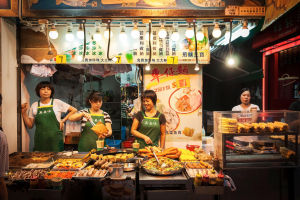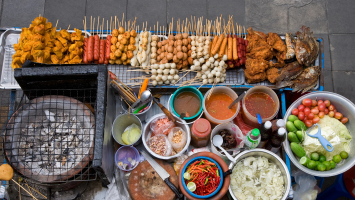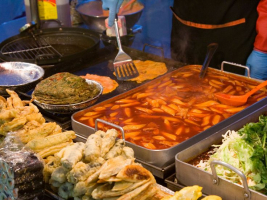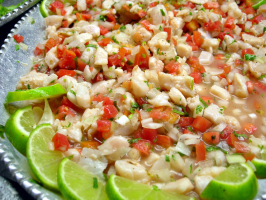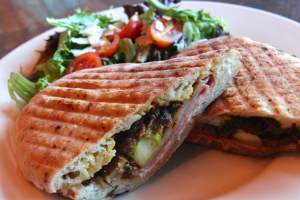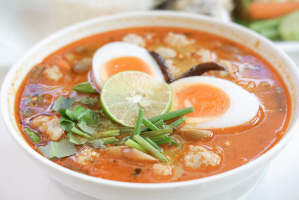Top 10 Best Street Food in Bali
Bali is a tourist destination with a lot of delicious food. Toplist has compiled the information and listed the 10 best street food in Bali. Let's find out ... read more...with Toplist!
-
One of the best street food in Bali is Babi Guling. It is a traditional Balinese dish that consists of roasted suckling pig. It is one of Bali's most famous and beloved dishes, often considered a must-try for visitors to the island. Babi Guling is typically prepared for special events, religious ceremonies, or as a festive meal.
The preparation of Babi Guling involves a series of steps to achieve its distinctive flavors and textures. The pig is typically seasoned with a blend of local spices and herbs, which may include turmeric, coriander, lemongrass, galangal, ginger, and garlic. The pig is then roasted whole on a spit over an open fire or in an oven until the skin becomes crispy and golden, while the meat remains tender and succulent.
Once cooked, the roasted pig is traditionally carved into various cuts, including the crispy skin, juicy meat, and flavorful parts like the belly and ribs. It is typically served with steamed rice, lawar (a mix of vegetables and grated coconut), sambal (spicy condiment), and other side dishes such as crispy pork crackling or fried innards.
The combination of tender meat, crispy skin, and aromatic spices creates a mouthwatering and unforgettable eating experience. Babi guling is often enjoyed as a communal meal, where people gather around to savor the flavorful roasted pig and share the various components of the dish.
While Babi Guling is most commonly found in Bali, it has gained popularity throughout Indonesia and in some international locations. In Bali, you can find Babi Guling served in dedicated warungs (local eateries), restaurants specializing in Balinese cuisine, or during special events and celebrations. Some renowned places to try Babi Guling in Bali include Ibu Oka in Ubud, Men Agus in Denpasar, and Warung Babi Guling Pak Malen in Seminyak.
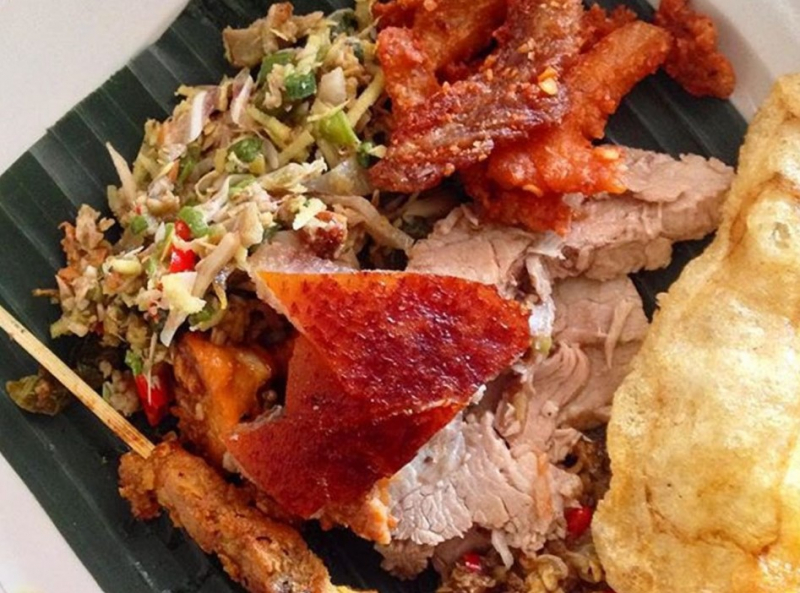
Screenshot via https://www.flokq.com/blog/en/bali/babi-guling-bali 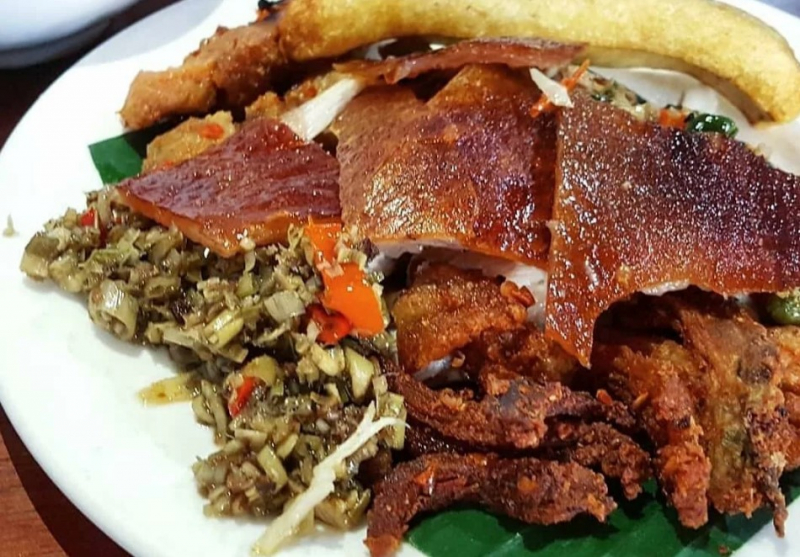
Screenshot via https://www.nibble.id/babi-guling-di-bali/ -
Nasi Goreng is a popular Indonesian dish that translates to "fried rice" in English. It is a flavorful and versatile dish that can be found throughout Indonesia, including Bali. Nasi goreng is typically made by stir-frying cooked rice with a combination of ingredients and seasonings.
The base of Nasi Goreng is steamed or leftover rice, which is then stir-fried in a wok or frying pan with a variety of ingredients. Common additions include diced vegetables like carrots, peas, and bell peppers, as well as proteins such as chicken, shrimp, beef, or tofu. It is also common to add aromatics like garlic, shallots, and chili peppers for flavor.
The dish is seasoned with various sauces and condiments such as soy sauce, kecap manis (sweet soy sauce), oyster sauce, and sometimes shrimp paste or fish sauce. This gives nasi goreng its distinct savory and slightly sweet flavor.
Nasi Goreng is often garnished with sliced cucumber, tomato, and a fried egg on top. It can be served as a standalone meal or accompanied by additional side dishes like krupuk (Indonesian crackers) or acar (pickled vegetables).
In Bali, nasi goreng can be found in local warungs (eateries), restaurants, and even street food stalls. It is a popular dish enjoyed by both locals and tourists alike. Each establishment may have its own variations and additions to the basic recipe, allowing for a diverse range of flavors and textures.
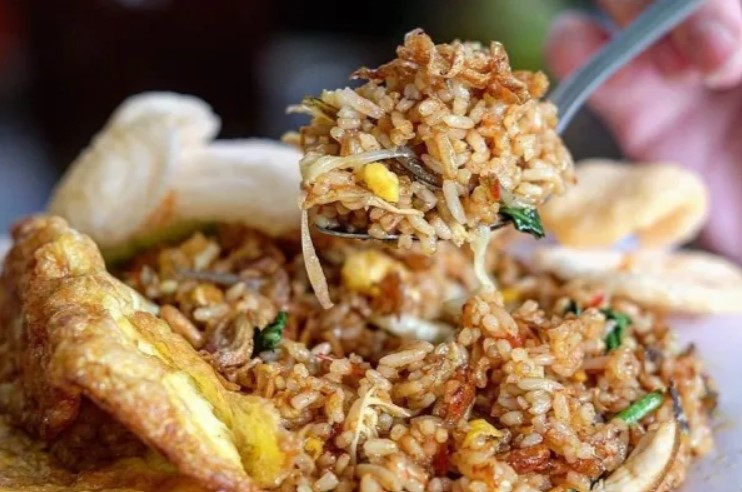
Screenshot via https://www.rukita.co/stories/aneka-resep-nasi-goreng 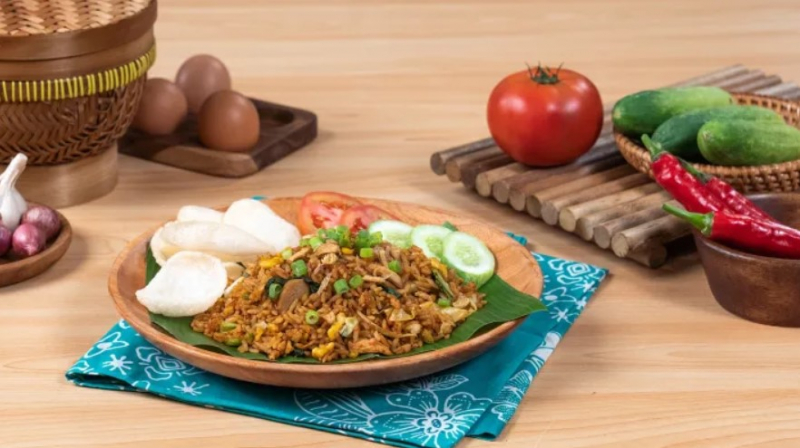
Screenshot via https://www.rukita.co/stories/aneka-resep-nasi-goreng -
Satay is a popular Southeast Asian dish that is enjoyed in various countries, including Indonesia, Malaysia, Thailand, and Singapore. It consists of skewered and grilled meat, typically served with a flavorful dipping sauce. Satay is often considered a staple street food and a favorite at local food stalls and night markets.
The meat used in satay can vary, but the most common options include chicken, beef, pork, or even goat. The meat is typically marinated in a mixture of spices and ingredients such as turmeric, cumin, coriander, garlic, lemongrass, and coconut milk. This marinade adds depth of flavor and tenderizes the meat.
The marinated meat is then skewered onto bamboo sticks or metal skewers and grilled over charcoal or an open flame. The grilling process imparts a smoky aroma and charred edges to the meat, enhancing its taste.
Satay is often served with a peanut-based dipping sauce, which is a combination of ground peanuts, spices, soy sauce, sugar, and sometimes tamarind or lime juice. The sauce adds a creamy and slightly sweet element that complements the savory grilled meat.
In addition to the dipping sauce, satay is commonly accompanied by a plate of cucumber and onion slices. These refreshing condiments provide a contrast to the richness of the meat and complement the flavors of the dish. This is one of the best street food in Bali.

Screenshot via https://www.thespruceeats.com/easy-thai-chicken-satay-peanut-sauce-3217147 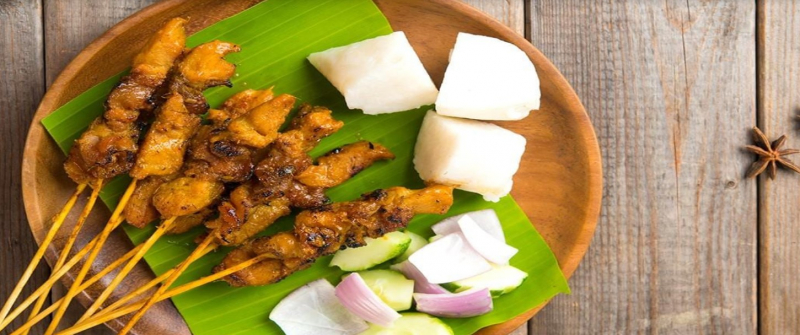
Screenshot via https://www.indonesia.travel/uk/en/trip-ideas/delicious-satay-indonesia-s-most-famous-dish -
Mie goreng is a popular Indonesian dish that translates to "fried noodles" in English. It is a flavorful and versatile stir-fried noodle dish that can be found throughout Indonesia, including Bali. Mie goreng is often enjoyed as a street food or a quick and satisfying meal.
The dish typically consists of egg noodles that are stir-fried with a combination of ingredients and seasonings. The noodles are boiled until they reach a tender consistency before being stir-fried in a wok or frying pan.
Mie goreng can be customized with a variety of ingredients based on personal preference or regional variations. Common additions include vegetables like cabbage, carrots, bean sprouts, and scallions. Proteins such as chicken, shrimp, beef, or tofu are often included to make the dish more substantial. Some variations may also incorporate ingredients like sliced bell peppers, mushrooms, or fried shallots.
The dish is flavored with a combination of sauces and seasonings, which may include soy sauce, kecap manis (sweet soy sauce), oyster sauce, chili sauce, and sometimes shrimp paste or fish sauce. These ingredients give mie goreng its savory, slightly sweet, and umami-rich taste.
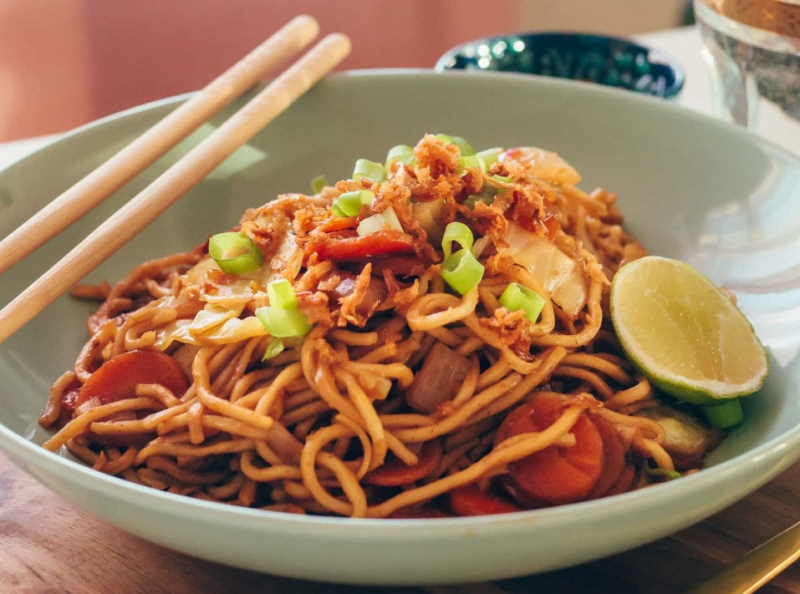
Screenshot via https://www.sunshineseeker.com/lifestyle/food/easy-indonesian-mie-goreng-recipe/ 
Screenshot via https://www.sunshineseeker.com/lifestyle/food/easy-indonesian-mie-goreng-recipe/ -
Bakso is a popular Indonesian street food dish that consists of meatballs served in a flavorful broth. It is a beloved comfort food that can be found throughout Indonesia, including Bali. Bakso stalls or vendors are a common sight in local markets, streets, and food courts.
The meatballs in Bakso are typically made from a mixture of ground beef with a small amount of tapioca starch or other binding agents. The meatball mixture is seasoned with various herbs, spices, and flavorings such as garlic, shallots, salt, pepper, and sometimes additional ingredients like spring onions or mushrooms for added texture and taste.
The meatballs are usually boiled or steamed until they become tender and springy. They are then served in a flavorful, clear broth that is made by simmering bones, herbs, and spices. The broth is often enhanced with flavors from ingredients like garlic, shallots, ginger, star anise, and soy sauce.
Bakso can be enjoyed in different variations. It is commonly served with yellow noodles, rice vermicelli, or bihun (rice noodles) in the broth. Additional toppings may include slices of beef, chicken, or tofu, as well as bean sprouts, fried shallots, and chopped celery or green onions. Spicy sambal (chili sauce) and sweet soy sauce are often provided as condiments for added flavor.
Apart from the traditional Bakso soup, there are also dry versions available. Dry Bakso is served with noodles, soy sauce, and sometimes a sweet and spicy chili sauce on the side. It offers a different eating experience with a combination of flavors and textures. This is one of the best street food in Bali.
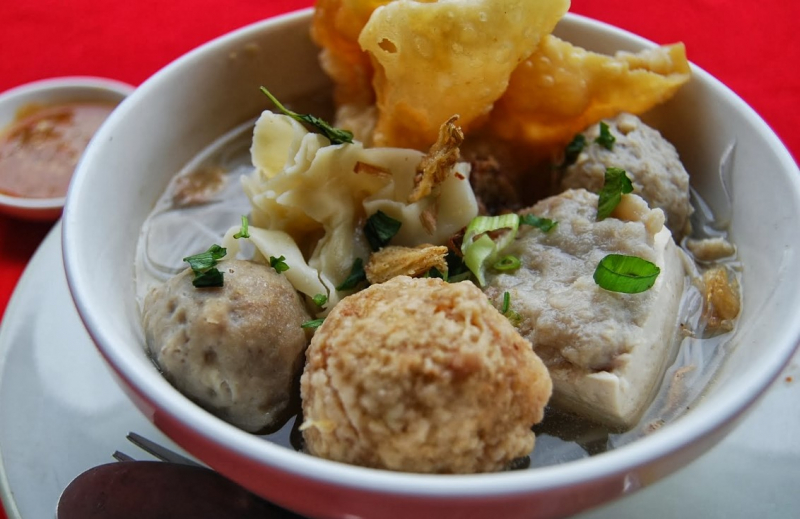
Screenshot via https://www.wandercooks.com/bakso-indonesian-meatball-soup/ 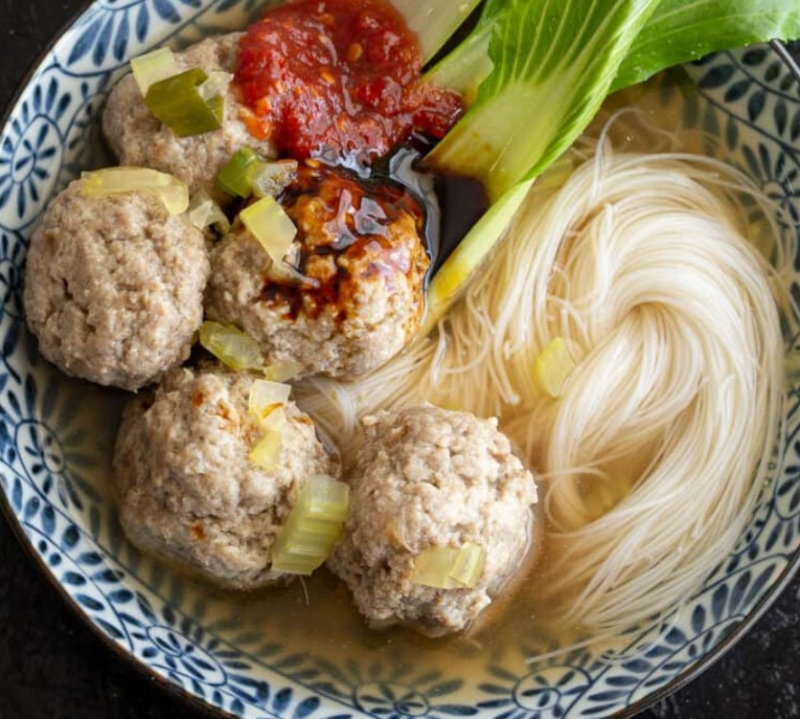
Screenshot via https://www.wandercooks.com/bakso-indonesian-meatball-soup/ -
A common description of Murtabak is a spicy folded omelette pancake with vegetable chunks. Murtabak is most commonly made from pan-fried crepes that have been filled with minced meat, chopped leeks, chives, or green onions (scallions), beaten eggs, and then folded and cut into squares. The murtabak, often called martabak, is one of the most well-liked street dishes in Indonesia.
A variety of Yemeni, Indian Muslim eateries in Singapore, notably those on Little India and Arab Street, provide vegetarian Murtabaks as well as variations with chicken and other stuffings.
There are two varieties of Murtabak, a popular street meal in Bali: Martabak manis and Martabak telur. Originally known as Terang Bulan or Martabak Manis, this thick and delicious pancake is typically covered with a variety of ingredients such as cheese, chocolate, peanuts, condensed milk, sesame seeds, and margarine. International favorites including Skippy Peanut Butter Spread, Ovomaltine, Toblerone, Lotus Biscoff, and Durian Spread are now common toppings for Murtabak.
Recently, Martabak Manis has also been available in a thin and crispy version called Martabak Tipis Kering. The savory kind, called Martabak Telur, are crispy pancakes topped with onions, eggs, and chicken or beef meat.

Screenshot via https://www.lokataste.com/murtabak-recipe/#google_vignette 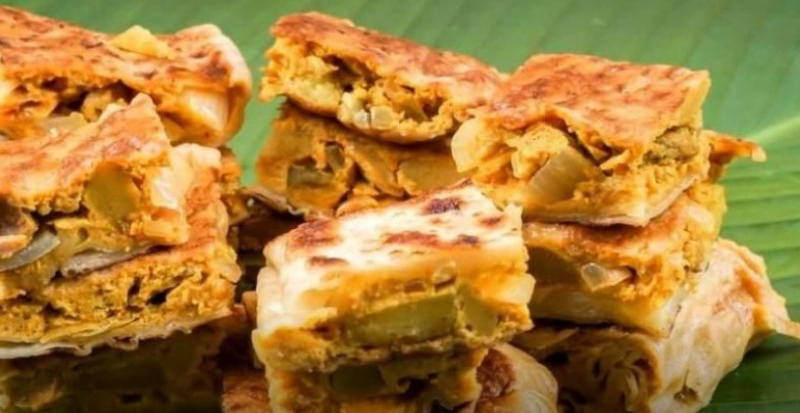
Screenshot via https://www.lokataste.com/murtabak-recipe/ -
Rujak is a traditional Indonesian fruit salad or a type of spicy fruit salad. It is a popular street food in Bali and other parts of Indonesia. Rujak typically combines a variety of tropical fruits with a spicy and tangy sauce made from chili, tamarind, palm sugar, and other seasonings.
The exact composition of rujak can vary, but common fruits used in the salad include mangoes, pineapples, guavas, jicama, cucumbers, and green apples. These fruits are typically cut into bite-sized pieces or thinly sliced.
The spicy sauce, known as rujak sauce or bumbu rujak, is the key component that gives the salad its distinctive flavor. The sauce is made by grinding together ingredients such as chili peppers, tamarind pulp, palm sugar, salt, and sometimes shrimp paste (terasi). The resulting sauce is a balance of spicy, sweet, tangy, and savory flavors.
To prepare rujak, the fruits are mixed together in a bowl or plate, and the spicy sauce is poured over them. The sauce is then tossed with the fruits, ensuring that the flavors are well combined. Sometimes, additional toppings such as roasted peanuts or fried shallots are added to enhance the texture and flavor of the salad.
Rujak is a refreshing and vibrant dish that showcases the tropical fruits of Indonesia. It offers a delightful combination of sweet, spicy, and tangy flavors, making it a popular choice for those seeking a unique and flavorful street food experience in Bali.
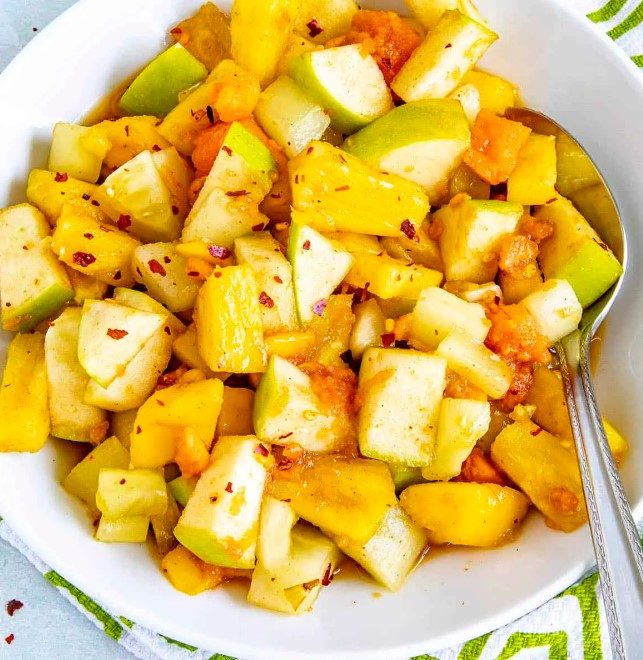
Screnshot via https://www.chilipeppermadness.com/recipes/rujak/ 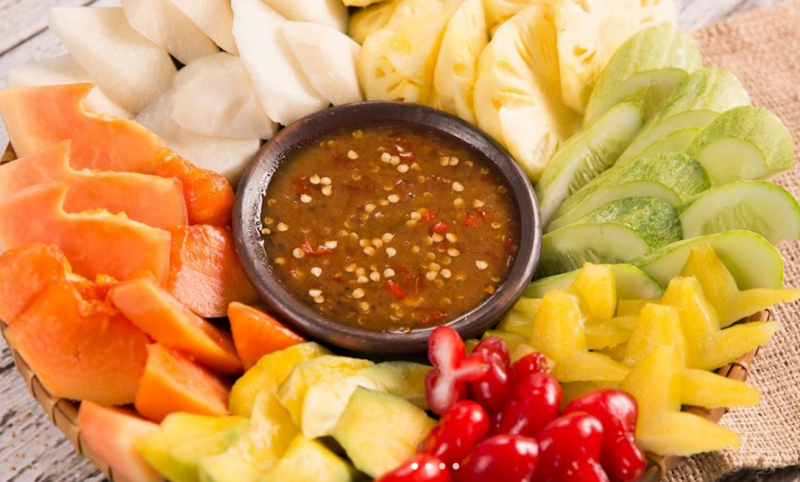
Screenshot via https://www.tasteatlas.com/rujak -
Terang Bulan, also known as Martabak Manis or Indonesian sweet pancake, is a popular street food and dessert in Indonesia, including Bali. It is a sweet and indulgent treat that is commonly enjoyed as a snack or dessert.
Terang Bulan is made by pouring a thick, sweet batter onto a hot griddle or pan. The batter typically consists of flour, eggs, sugar, yeast, and milk. It is then cooked until the bottom becomes golden brown and crispy, while the top remains soft and fluffy.
Once the pancake base is cooked, various sweet fillings and toppings are added to enhance the flavor. Some common fillings include chocolate sprinkles, grated cheese, crushed peanuts, sweetened condensed milk, Nutella, or a combination of these ingredients. The fillings are sprinkled over the pancake base, and then it is folded or rolled to enclose the filling.
Terang Bulan is often served hot and fresh, straight from the griddle. It is usually cut into smaller pieces or slices before being served. The combination of the soft and fluffy pancake base with the sweet fillings creates a delightful contrast in textures and flavors.
In Bali and other parts of Indonesia, you can find Terang Bulan being sold from street food stalls, night markets, or specialized Terang Bulan vendors. It is a popular treat that is enjoyed by locals and tourists alike. If you have a sweet tooth and enjoy indulgent desserts, trying Terang Bulan in Bali is definitely worth considering.
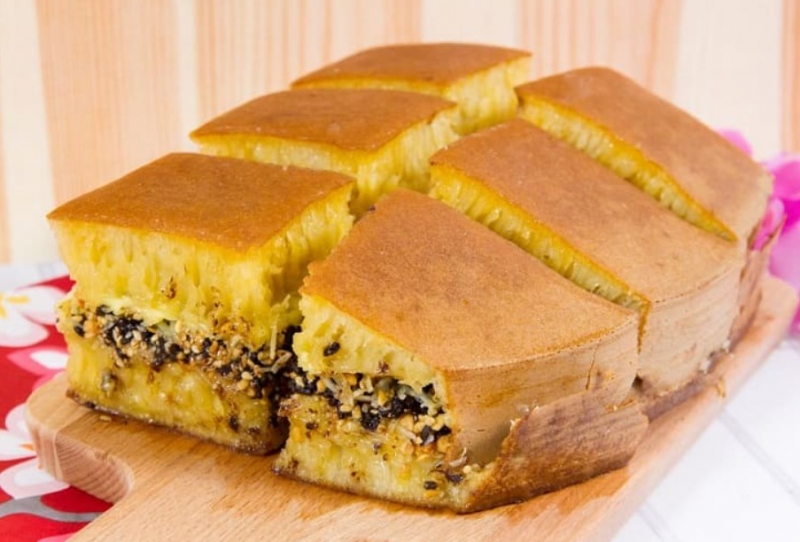
Screenshot via https://wiratech.co.id/cara-membuat-terang-bulan/ 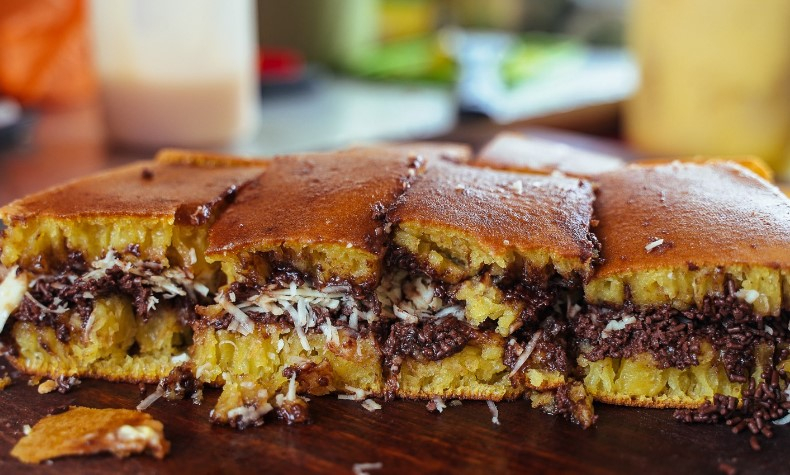
Screenshot via https://jessicabakery.com/resep-terang-bulan/ -
Pisang Rai which is one of the best street food in Bali, is a traditional Balinese dessert made with bananas and grated coconut. It is a sweet and flavorful treat that is commonly enjoyed in Bali.
To make Pisang Rai, ripe bananas are steamed or boiled until they become soft and tender. The bananas are then sliced and coated with a mixture of grated coconut and palm sugar. The grated coconut is often mixed with a bit of salt to enhance the flavor.
The palm sugar used in Pisang Rai gives it a rich and caramel-like sweetness. The combination of the sweet, caramelized palm sugar and the creamy grated coconut adds a delightful taste and texture to the dish.
Pisang Rai is typically served at room temperature or chilled. It can be enjoyed as a dessert after a meal or as a sweet snack throughout the day. It is a popular traditional Balinese sweet that showcases the use of local ingredients such as bananas and coconut.
If you have the opportunity to visit Bali or try Balinese cuisine, consider sampling Pisang Rai to experience the unique flavors and culinary traditions of the region.
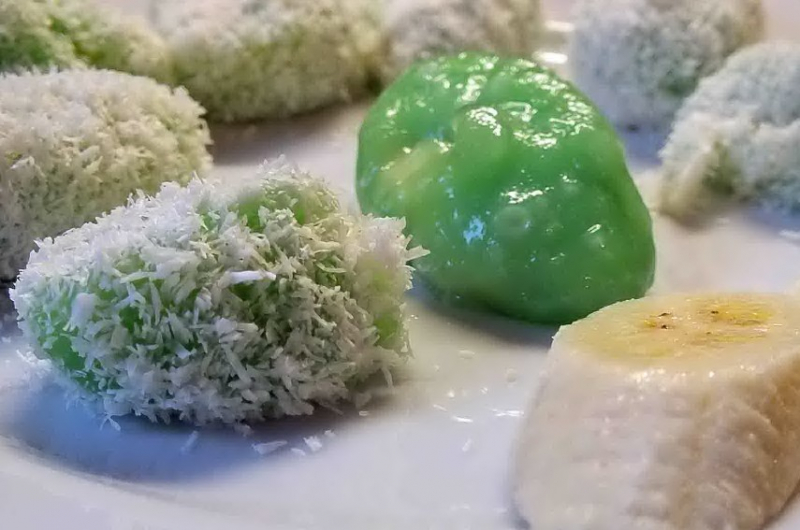
Screenshot via https://www.kooliner.com/blog/pisang-rai-olahan-pisang-khas-bali/#google_vignette 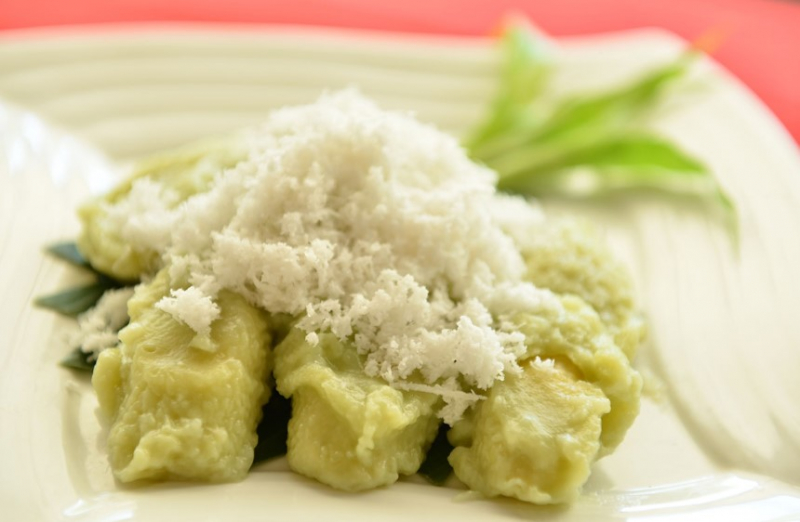
Screenshot via https://www.kooliner.com/blog/pisang-rai-olahan-pisang-khas-bali/#google_vignette -
Nasi Tepeng is a traditional Balinese rice dish that is known for its aromatic flavors and rich texture. It is a popular breakfast or brunch option in Bali, especially in the Gianyar region.
Nasi Tepeng is made by first cooking white rice with coconut milk, water, and a pinch of salt. As the rice cooks, it absorbs the creamy coconut flavor, resulting in a fragrant and slightly sweet taste. The rice is typically cooked until it becomes soft and sticky.
Once the rice is cooked, it is served in a bowl or on a plate, and various toppings and condiments are added to enhance the dish's flavors. Common toppings for Nasi Tepeng include shredded coconut, fried peanuts, fried anchovies, fried shallots, sliced cucumber, and a spicy sambal sauce. Sometimes, additional ingredients such as boiled eggs or grilled chicken may also be added.
Nasi Tepeng offers a combination of savory, sweet, and spicy flavors, along with different textures from the toppings. It is a hearty and satisfying dish that provides a blend of richness from the coconut milk and crispiness from the fried components.
While Nasi Tepeng is often enjoyed as a breakfast or brunch dish, it can also be eaten throughout the day as a main meal or snack.
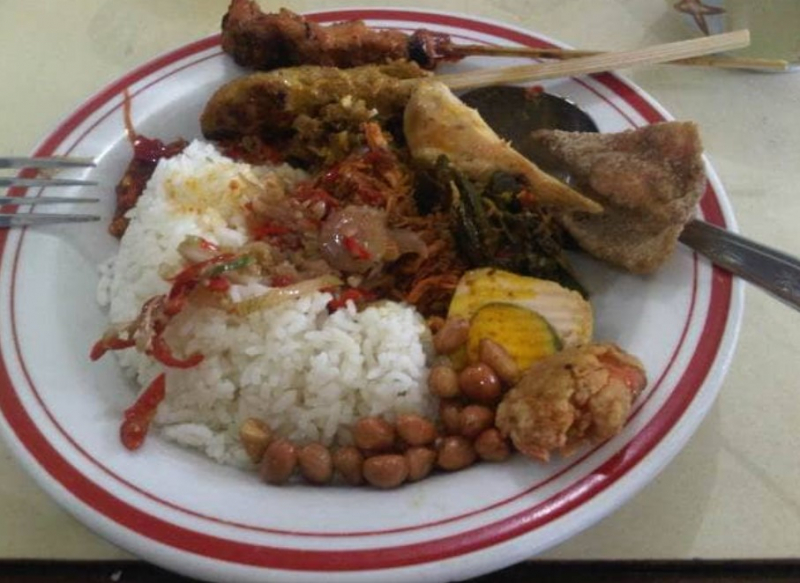
Screenshot via https://www.gotravelly.com/blog/makanan-khas-bali/ 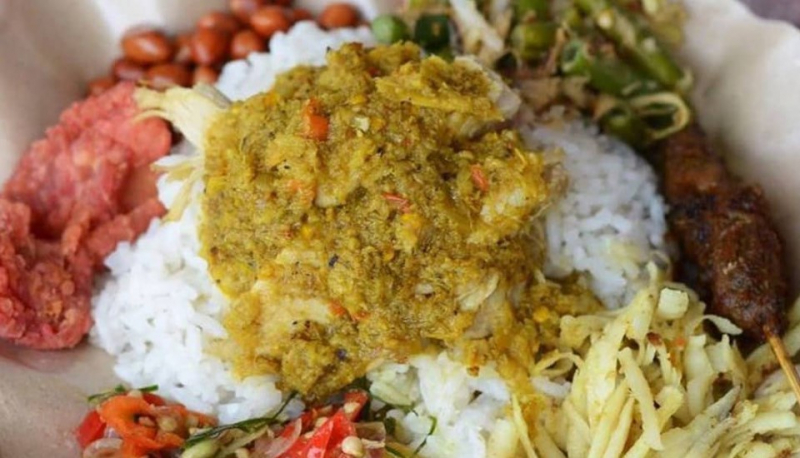
Screenshot via https://blog.sayurbox.com/5-cara-membuat-nasi-tepeng-khas-gianyar/












